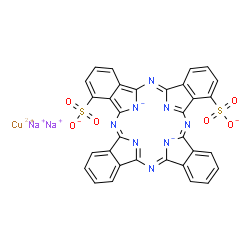C.I. Solvent Blue 38

C.I. Solvent Blue 38 structure
|
Common Name | C.I. Solvent Blue 38 | ||
|---|---|---|---|---|
| CAS Number | 1328-51-4 | Molecular Weight | 778.15 | |
| Density | N/A | Boiling Point | N/A | |
| Molecular Formula | C32H12CuN8Na2O6S2 | Melting Point | ca 235℃ | |
| MSDS | USA | Flash Point | N/A | |
|
Autophagy regulates the therapeutic potential of mesenchymal stem cells in experimental autoimmune encephalomyelitis.
Autophagy 10(7) , 1301-15, (2014) Mesenchymal stem cell (MSC)-based therapy is a promising approach to treat various inflammatory disorders including multiple sclerosis. However, the fate of MSCs in the inflammatory microenvironment is largely unknown. Experimental autoimmune encephalomyeliti... |
|
|
Optic neuritis in different strains of mice by a recombinant HSV-1 expressing murine interleukin-2.
Invest. Ophthalmol. Vis. Sci. 50(7) , 3275-82, (2009) The authors have shown previously that a recombinant HSV-1 that constitutively expresses two copies of murine IL-2 (HSV-IL-2) induces demyelination by activated CD8(+) T cells in the brain and spinal cord of ocularly infected female BALB/c mice. The present s... |
|
|
17beta-estradiol protects male mice from cuprizone-induced demyelination and oligodendrocyte loss.
Neurobiol. Dis. 39(2) , 127-37, (2010) In addition to regulating reproductive functions in the brain and periphery, estrogen has tropic and neuroprotective functions in the central nervous system (CNS). Estrogen administration has been demonstrated to provide protection in several animal models of... |
|
|
Postinjury estrogen treatment of chronic spinal cord injury improves locomotor function in rats.
J. Neurosci. Res. 88(8) , 1738-50, (2010) Spinal cord injury (SCI) causes loss of neurological function and, depending on serverity, may cause paralysis. The only recommended pharmacotherapy for the treatment of SCI is high-dose methylprednisolone, and its use is controversial. We have previously sho... |
|
|
Full tensor diffusion imaging is not required to assess the white-matter integrity in mouse contusion spinal cord injury.
J. Neurotrauma 27(1) , 253-62, (2010) In vivo diffusion tensor imaging (DTI) derived indices have been demonstrated to quantify accurately white-matter injury after contusion spinal cord injury (SCI) in rodents. In general, a full diffusion tensor analysis requires the acquisition of diffusion-we... |
|
|
Inhibition of inflammation and oxidative stress by Angelica dahuricae radix extract decreases apoptotic cell death and improves functional recovery after spinal cord injury.
J. Neurosci. Res. 90(1) , 243-56, (2012) Inflammation and oxidative stress play major roles in the pathogenesis after spinal cord injury (SCI). Here, we examined the neuroprotective effects of Angelica dahuricae radix (ADR) extract after SCI. ADR extract significantly decreased the levels of proinfl... |
|
|
Cuprizone treatment induces demyelination and astrocytosis in the mouse hippocampus.
J. Neurosci. Res. 87(6) , 1343-55, (2009) Memory impairment is outstanding within the spectrum of cognitive deficits in multiple sclerosis (MS) patients. Demyelination has been reported in the hippocampus formation of MS patients. The degree of hippocampus lesions in MS strongly correlates with progr... |
|
|
Micropipette tips--the unsung heroes of mass spectrometry.
Rapid Commun. Mass Spectrom. 22(15) , 2349-54, (2008) Micropipette tip (tip) pipetting accuracy and precision are functions of tip manufacture consistency, morphological variation, and retained inner tip wall particulate matter. Irregular tip inner wall surfaces and retained particulate matter cause pipetting in... |
|
|
2-BFI ameliorates EAE-induced mouse spinal cord damage: effective therapeutic time window and possible mechanisms.
Brain Res. 1483 , 13-9, (2012) Our previous studies showed that ligands to type 2 imidazoline receptors (I₂R), including 2-(2-Benzofuranyl)-2-imidazoline (2-BFI) and Idazoxan, were effective in reducing spinal cord inflammation caused by experimental autoimmune encephalomyelitis (EAE). In ... |
|
|
[Protocol for the combination of neurohistological techniques on vibratome obtained sections].
Biomedica. 31(3) , 444-50, (2011) The histological study of the nervous system requires the use of special techniques. Currently, no methods are available to visualize simultaneously all the cellular constituents of nervous tissue. |